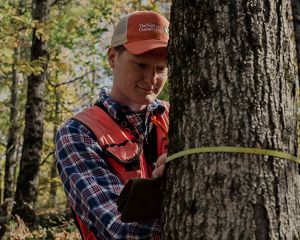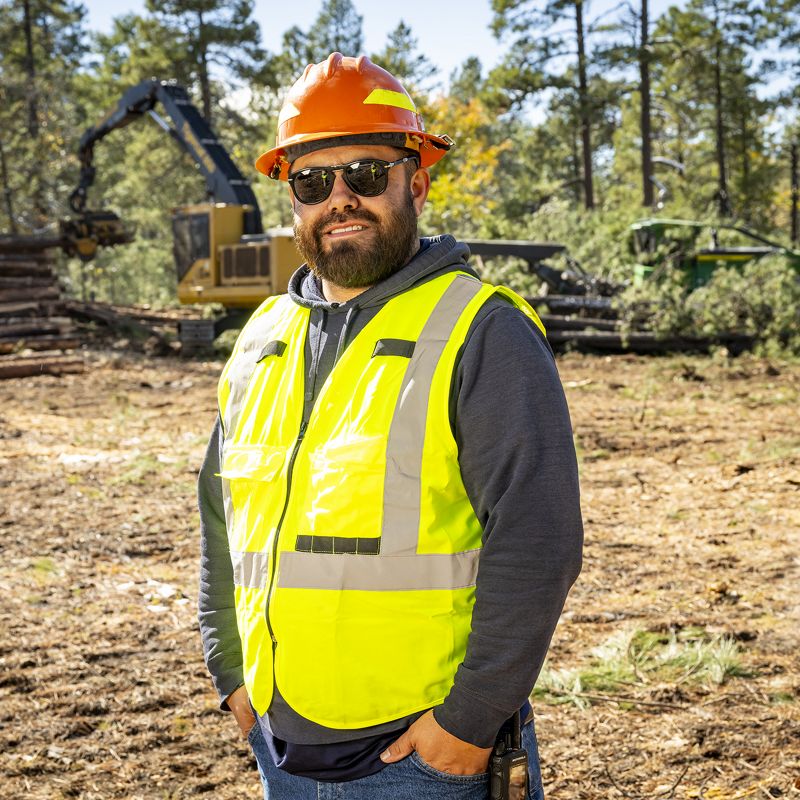
How This Family Lumberjack is Aiding Arizona's Fire-Prone Forests
Federal funds help Devon Suarez revive ponderosa forests and support his family business
Devon Suarez, owner of the timber company Suarez Forestry, is bucking a national trend.
Suarez is 35, in an industry where the average age of company owners is 55 years. And while many young workers flee rural towns for opportunities elsewhere, Suarez has stayed put.
“The reality of this work,” Suarez says, “is that the workforce is aging quickly, and there’s not a lot of young people that are doing it.” This leaves the U.S. Forest Service and other government land agencies in a bind. There are too few forestry professionals to care for the millions of acres of public forestland in the United States.
Suarez, who grew up playing in the woods while his dad, grandpa and uncles worked as lumberjacks, took a “a leap of faith” to start a timber company in 2017. Suarez Forestry, which operates out of Heber, Ariz., is now a key custodian of Arizona’s forests. By selectively logging overcrowded ponderosa pines, Suarez and his family are reducing the risk of out-of-control wildfires—critical work in a state that’s already dry and getting drier.
But running a logging operation is tough. Profit margins are razor thin. That’s why conservation dollars from laws such as the Inflation Reduction Act—the federal government’s biggest-ever investment in climate action—are crucial. By funding projects that keep Suarez’s company in the black, the IRA helps to maintain the forestry workforce that, in turn, maintains forest health.
How the Inflation Reduction Act Creates Jobs
The Inflation Reduction Act, signed into law in 2022, is the federal government’s biggest-ever investment in climate action. This law has already provided hundreds of billions of dollars for clean energy and conservation projects, including an array of programs to restore forest, waterway and soil health.
The IRA’s investments are expected to create 9 million new jobs between 2022 and 2032, including 600,000 jobs protecting “natural infrastructure” such as forests and wetlands. These jobs include positions for foresters, scientists, engineers, construction workers, loggers, support staff and more.
Turning a family tradition of forest care into a thriving business
“For me, there’s nothing more important than family,” Suarez says. Although he went to college for political science and later graduated from law school, he knew all along that what he really wanted to do was start a timber business. “I envisioned it as a family company,” he says. “Being able to provide better opportunities, better pay, better benefits.”
In his final year of law school, a representative from The Nature Conservancy reached out to ask if he and his family were available to work on a large-scale forest restoration project. Suarez seized the opportunity to launch his company. He withdrew his life savings, while his mom cashed out her retirement. It was a big risk. The machinery they rented was expensive, roughly $30,000 a month, and so was the fuel to run it.
At the beginning, the going was tough but manageable—until the sawmill that TNC had contracted with shut down. “All of sudden, instead of taking logs 15 miles down the road … you have to take them 160, 170 miles down the road,” Suarez says. If not for TNC, which made sure his company continued to get paid, “we would have gone under as well.”
Quote: Devon Suarez
"I envisioned it as a family company ... Being able to provide better opportunities, better pay, better benefits.”
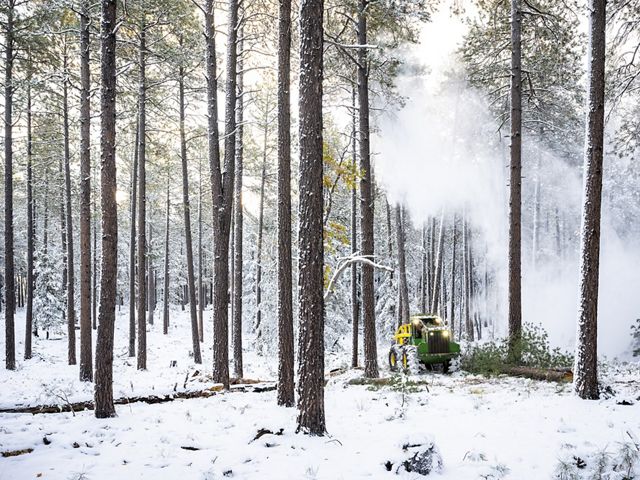
From tinderboxes to healthy forestland
Suarez’s company had its work cut out for it. Arizona is home to the world’s largest ponderosa pine forest, which sprawls from the Grand Canyon into New Mexico. But the forest’s enormous size belies its flagging health.
Historically, there were between five and 150 ponderosa pines per acre, says Thomas “Timber Tom” Dauenhauer, a Forest Service representative who has worked with Suarez on multiple projects. Now, after decades of wildfire suppression, that number is as high as 1,500. A decades-long drought is stressing trees even further, turning Arizona’s forests into tinderboxes.
Selective logging restores historical forest structure by leaving the healthiest and largest trees while harvesting the rest. This gives the remaining pines the room they need to thrive. “After we cut off competition, there’s more soil, more moisture, more sunlight,” Dauenhauer says. “If they’re young enough,” he says, “they’ll put on some pretty significant height.”
Forest thinning also frees up water resources, rejuvenating springs and streams that have dried up. According to TNC research, forest thinning results in up to 20% more water returning to waterways and aquifers.
Turning low-value trees into electricity
Suarez works with TNC to help implement the Forest Service’s Four Forest Restoration Initiative. 4FRI is working to restore 2.4 million acres of ponderosa pineland in four national forests in Arizona—the Kaibab, Coconino, Apache-Sitgreaves and Tonto. The initiative uses a mix of tree thinning, tree planting, prescribed fire and other interventions to tame the ferocity of wildfires and fortify forests against the effects of a changing climate.
The Inflation Reduction Act and the 2021 Infrastructure Investment and Jobs Act are key contributors to 4FRI. Between 2021 and 2024, these two laws contributed significant funds to the overall initiative, resulting in a large number of acres restored in a relatively short time span.
To help finance the costs of restoration work, 4FRI is looking to create new uses and markets for the harvested trees. But there’s a catch. Ponderosa pine is a low-value wood. The logs Suarez harvests are “almost economically nonviable,” he says, and the long distances his team must haul them to sawmills sends costs spiraling.
One solution is to turn the harvested pines into electricity. In 2024, a $2 million IRA grant financed the Sawmill Springs Biomass Pilot, which gathered data on biomass removal while thinning 685 acres in the Kaibab National Forest. Rather than processing the larger trunks for timber, and piling branches and smaller trees to be burned on-site, the entirety of every tree was ground into chips. These chips were then trucked to Novo Biopower, an electricity-generating facility in Snowflake, Ariz. Suarez’s company cut the trees, while another company chipped them.
The results from the project are still being analyzed, but one finding was immediately clear: treating the trees as biomass alone saves a significant amount of time. On a project of this size, the harvesting portion alone would normally take between six and nine months. For the pilot, harvesting was completed in under 50 days.
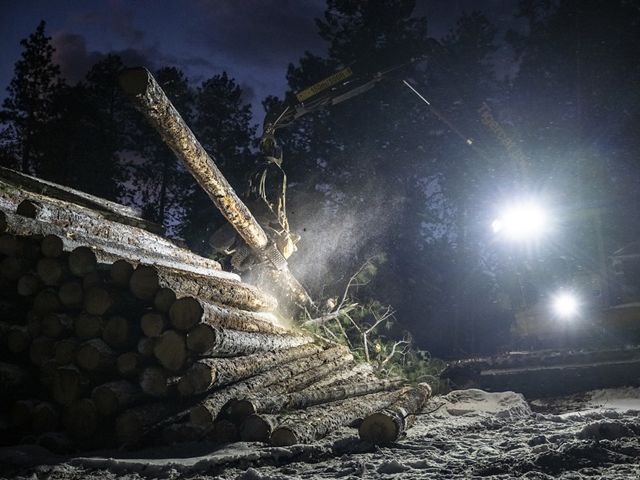
Arizona’s forests depend on foresters. Foresters depend on political support.
Suarez emphasizes how important the IRA and other conservation investments are to his business. His message to lawmakers? “I want them to be aware of how those funds have helped,” he says.
Suarez estimates his company has tripled its capacity to thin forested acres since its launch, making it one of the top logging businesses in Arizona. But it still faces many challenges. The company struggles to retain workers who can handle the exhausting hours and long stretches of time living in RVs in remote areas. “Family members are the ones that stuck around,” Suarez says. “Everyone else comes and goes.”
At the same time, the Forest Service lacks the capacity and resources to assign work to contractors at the pace and scale needed to tackle the enormity of the forest health problem. Suarez says he’s heartened by the fact that state agencies in Arizona now have the authority to administer Forest Service projects, which will increase the rate of ponderosa restoration.
In addition, a 2024 agreement with the Forest Service allows TNC to carry out forest restoration work on all Forest Service lands in Arizona and New Mexico, as well as utilize Forest Service funds to support this work on lands managed by states, tribes and other federal agencies.
Suarez says his company is eager to help. “We’re here, we’re available, we’re ready to keep going.”
Take Action
Government action on conservation is at an all-time high. We need to keep that going. Tell Congress to protect conservation funding today.
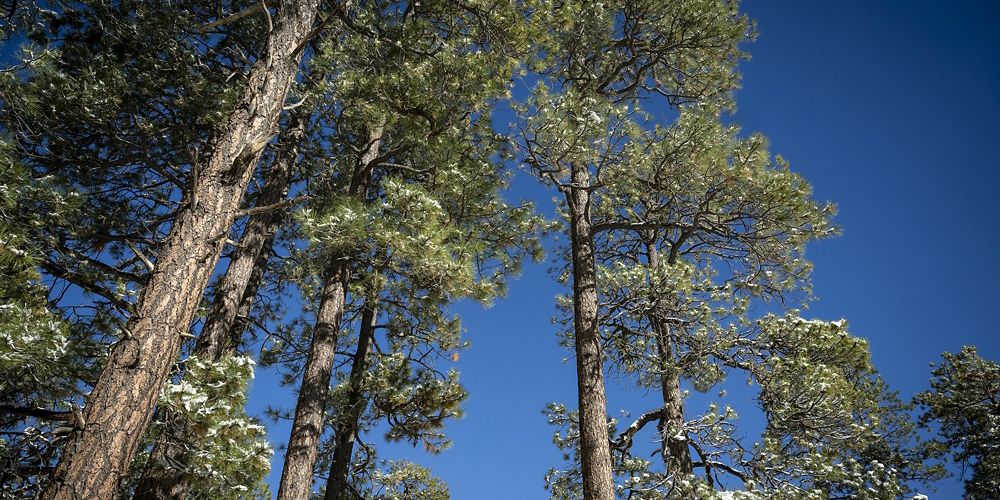

Stay in the Loop
Get conservation stories, news and local opportunities from where you live.










